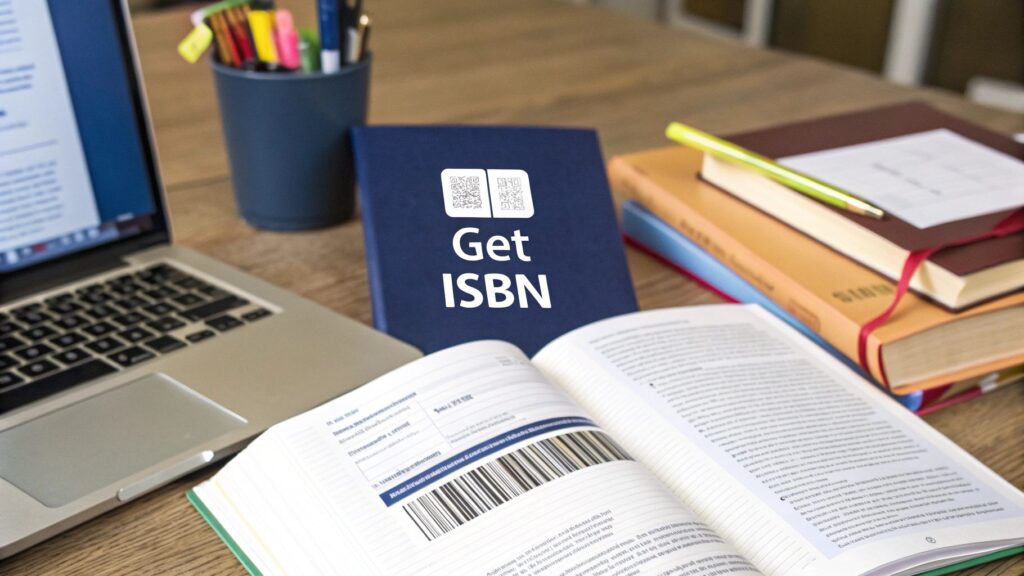Thinking about getting an ISBN for your book? The only way to do it right is to go directly to your country's official source. For authors in the U.S., that's Bowker, and for those in the U.K., it's Nielsen.
You might see offers for "free" ISBNs from platforms like Amazon, and while tempting, they come with some serious strings attached. If you want full control over your book's future and the freedom to sell it anywhere, buying your own is non-negotiable.
Why Your Book Needs an Official ISBN
Before we dive into the "how," let's talk about the "why." An International Standard Book Number (ISBN) isn't just a formality; it's your book's passport to the global marketplace. This unique 13-digit code is its fingerprint, and without it, your book is virtually invisible to the entire publishing supply chain.
Think about it from a bookstore's perspective. When they need to order your paperback, they don't just search for the title. They punch in the ISBN to make sure they get the exact edition and format they need. This little number is what allows bookstores, libraries, and online retailers to track, order, and manage your title with precision.
The Foundation of Book Distribution
Getting an official ISBN is the first real step you take as a publisher, putting your book on the map for worldwide distribution. The system itself has been around since 1970 and is coordinated by the International ISBN Agency. However, they don't issue the numbers directly. Instead, they delegate that responsibility to national agencies in different territories.
This is what you’ll see when you visit the global agency’s homepage.
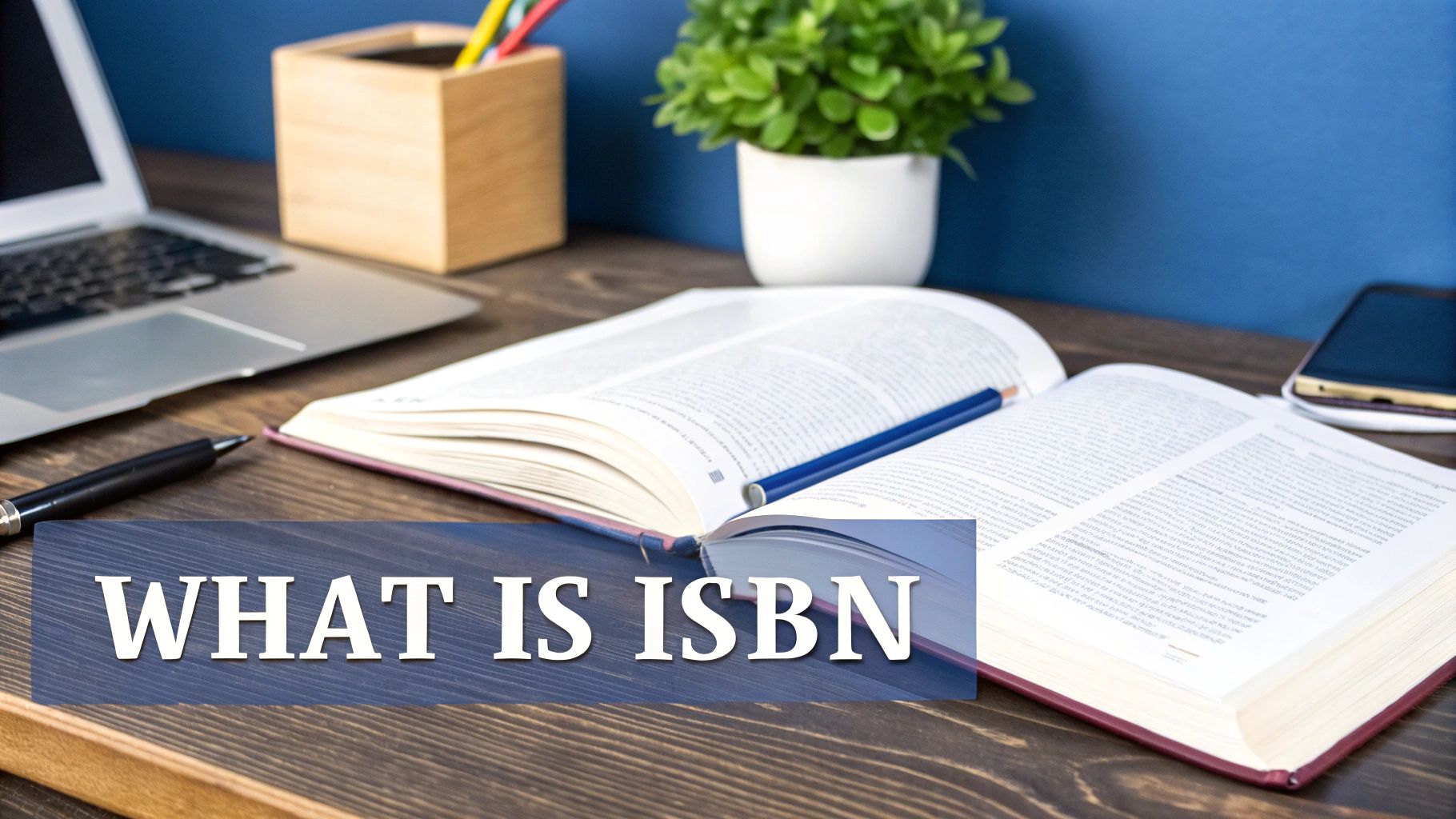
Notice how the first thing they prompt you to do is "Find your national agency." This underscores a crucial point: you have to get your ISBN from the correct regional authority.
Differentiating Formats and Editions
Here’s a rule of thumb I tell every new author: every format of your book needs its own unique ISBN. This is one of the most common points of confusion, so let it sink in. Your paperback, hardcover, audiobook, and various ebook versions are all distinct products.
Let's break it down with some real-world examples:
- Print Versions: Your paperback and hardcover editions have different production costs, cover designs, and retail prices. They absolutely need separate ISBNs.
- Ebook Versions: An EPUB file sold on Kobo and a MOBI file for Amazon's Kindle are different formats. Each one needs its own identifier.
- New Editions: If you release a second edition with substantial updates—more than just fixing a few typos—it requires a brand-new ISBN to differentiate it from the first version.
Trying to use one ISBN for multiple formats creates a logistical nightmare for retailers. It leads to incorrect orders, confused distributors, lost sales, and ultimately, frustrated readers who can't find the version of your book they want.
Finding Your Country's Official ISBN Agency
First things first: where you get your ISBN isn't a shopping choice. It's determined entirely by where you live. This is a common tripwire for new authors—getting it wrong means you could end up with an invalid number for your primary market, wasting both time and money.
The only way to secure a legitimate ISBN is by going directly to the official agency designated for your country. This global system ensures every number is unique and correctly cataloged worldwide. For example, if you're an author in the United States, your one and only source is Bowker (via their MyIdentifiers.com site). Over in the United Kingdom, that responsibility belongs to Nielsen. You simply can't buy a US ISBN from Nielsen, or a UK one from Bowker. The system won't allow it.
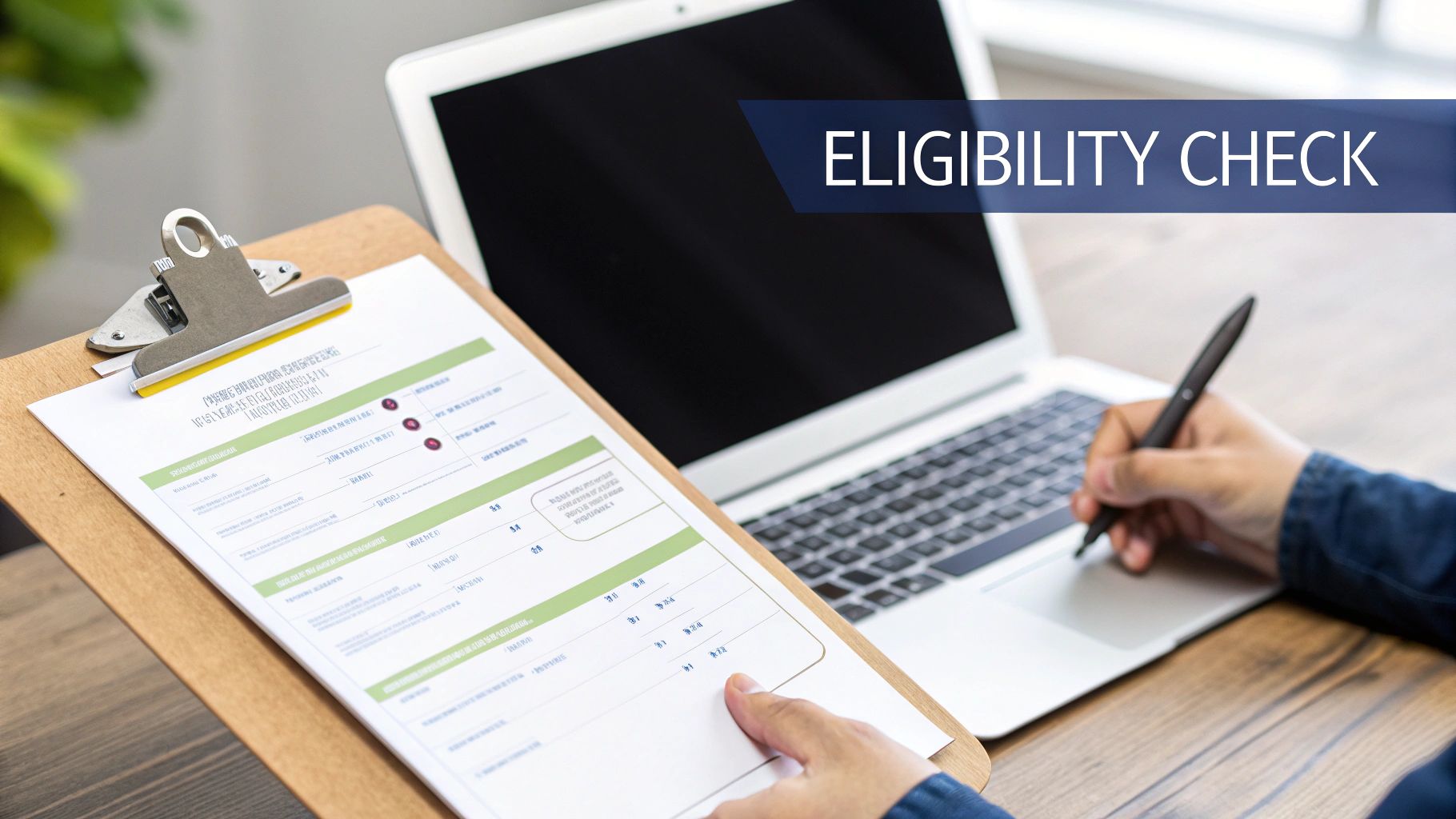
Using The Global Agency Directory
So, what if you're not in the US or UK? The process is just as simple. The International ISBN Agency acts as the central hub and maintains a global directory. Just head to their website and use the "Find your national agency" tool to pinpoint the exact provider for your region.
Taking this step is crucial for another big reason: it helps you sidestep third-party resellers. These companies often purchase ISBNs in bulk and sell them off one by one, which sounds easy enough. But there’s a massive catch.
When you buy an ISBN from a reseller, they are often listed as the publisher of record, not you. This severs your direct control over your book's metadata and can create major headaches down the line if you need to make changes or prove ownership.
By going straight to the source—your country’s official agency—you ensure that you or your publishing entity is listed as the publisher. This gives you complete and undisputed control over your work. For a deeper dive into this topic, you can explore the nuances of where to buy an ISBN to protect your publisher status.
A Quick Guide For Major Territories
To make your search easier, I've compiled a quick-reference guide to the designated ISBN agencies for major English-speaking countries.
Official ISBN Agencies for Major English-Speaking Countries
| Country | Official Agency | Key Information |
|---|---|---|
| United States | Bowker | The exclusive agency for all US-based authors and publishers. |
| United Kingdom | Nielsen | The official provider for publishers based in the UK and Ireland. |
| Australia | Thorpe-Bowker | The designated agency for all Australian publishing activities. |
| Canada | Library and Archives Canada | Canadian publishers can receive ISBNs for free from this agency. |
| New Zealand | National Library of New Zealand | The official source for all publishers operating in New Zealand. |
No matter where you are, always start your search at your country's official agency. It's the only way to guarantee your ISBN is valid, properly registered to you, and ready for the global market.
Understanding the Real Cost of an ISBN
Let's talk money. For many authors, the cost of an ISBN can be a real surprise. It’s an essential investment if you're serious about publishing, but the price tag isn't a simple one-size-fits-all deal. How much you'll pay really depends on where you live and how many you buy at once.
If you’re publishing in the United States, your one-stop shop is Bowker. They are the official ISBN agency for the U.S., and their pricing really highlights the value of thinking long-term.
Breaking Down the Bulk Savings
Grabbing a single ISBN from Bowker will set you back $125. That can feel like a big chunk of cash, especially for a debut author on a tight budget.
This is where buying in bulk becomes a game-changer. A block of 10 ISBNs costs $295, which slashes the per-book price down to just $29.50. If you're building a career and know you'll be publishing multiple books—or even different formats of the same book (paperback, hardcover, ebook)—the savings get even better. A block of 100 ISBNs is $575, which means each one costs a mere $5.75. That’s a massive discount.
This image gives a quick visual of the process.
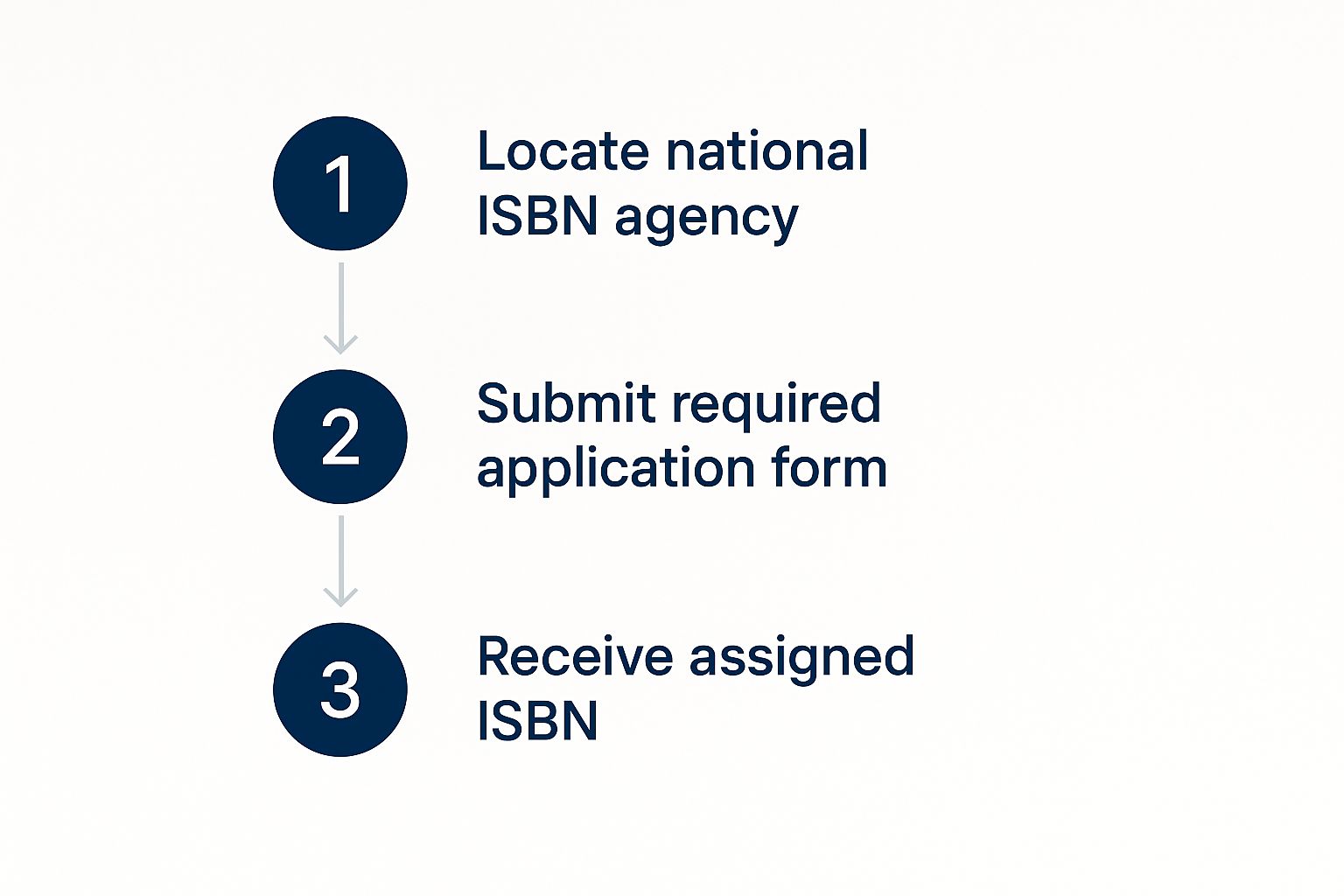
As you can see, going through your official agency is pretty straightforward.
The Hidden Costs of "Free" ISBNs
You’ve probably seen offers from platforms like Amazon KDP or Draft2Digital for a free ISBN. The word "free" is always tempting, but in this case, it comes with some serious strings attached that could hamstring your book's future.
When you take a free ISBN, the platform providing it—not you—is listed as the official publisher of record.
This creates a couple of big problems:
- You're Locked In: That free ISBN is tied exclusively to their platform. If you get an ISBN from Amazon KDP, you can't use it to sell your book on Barnes & Noble or through any other distributor. It's theirs, not yours.
- You Lose Control: Having Amazon listed as your publisher can look unprofessional to libraries and bookstores. More importantly, it separates you from having direct control over your book's metadata in the global retail system.
Think of it this way: a free ISBN makes you a tenant on their publishing platform. Owning your own ISBN makes you the landlord of your own publishing imprint.
If you want the freedom to sell your book anywhere and everywhere, buying your own ISBN is the only real path forward. It's a business decision, plain and simple.
For a deeper dive into the nuts and bolts of the entire process, you can get more information on how to get an ISBN for a book and make the best choice for your career. Owning your ISBN from day one ensures that in the eyes of the global publishing industry, your book belongs to you and you alone.
Let’s Walk Through the ISBN Application
Getting your ISBN might feel a bit intimidating at first, but it’s actually a pretty logical process. I’ll walk you through how it typically works, using Bowker's MyIdentifiers.com as our main example since they're the official agency for authors in the United States.
Your first move is to set up a publisher account. This step officially establishes you or your publishing company as the imprint of record.
This is a bigger deal than it sounds. The name you enter here—whether it’s your personal name or a cool publishing name like "Mountain Peak Press"—gets permanently tied to every ISBN you buy. So, take a minute to decide before you dive in.
Getting Your Book’s Metadata Just Right
With your publisher account ready, it's time to assign an ISBN to your book. This is where you'll input your book’s metadata, which is just a fancy term for all the core details that tell the world what your book is about. Accuracy here is everything.
You’ll be asked for several key pieces of information:
- Title and Subtitle: Make sure these are identical to what’s on your cover and title page. No exceptions.
- Author(s) and Contributors: List yourself, of course, but don't forget your illustrator, editor, or whoever wrote the foreword.
- Book Format: This is critical. You need to specify if this ISBN is for the paperback, the hardcover, or the EPUB. Remember, each format needs its own ISBN.
- Publication Date: This is simply the date you intend to release the book.
Before you hit that submit button, check everything one last time. A small typo in the title or clicking the wrong format can create major headaches with retailers and distributors down the road. While you’re thinking about distribution, it's also worth exploring different publishing paths. Sometimes, finding reputable publishers for new authors means they'll handle the ISBN for you, which is a different route altogether.
My Two Cents: Think of the metadata as your book's DNA. Once you lock it to an ISBN, it's set in stone. Give this step the same attention to detail you gave your final manuscript edit.
Finalizing the assignment is usually just a click of a button. And just like that, the 13-digit number is officially yours, ready to be placed on your book’s back cover and copyright page.
If you want an even more detailed walkthrough, our guide on how to get an ISBN for my book breaks it down even further.
So, you’ve got your first ISBN. That’s a huge step, but the work isn't over if you're planning to release your book in more than one format.
Here’s a rule I’ve seen trip up countless authors: each unique format of your book is a distinct product, and it absolutely requires its own ISBN.
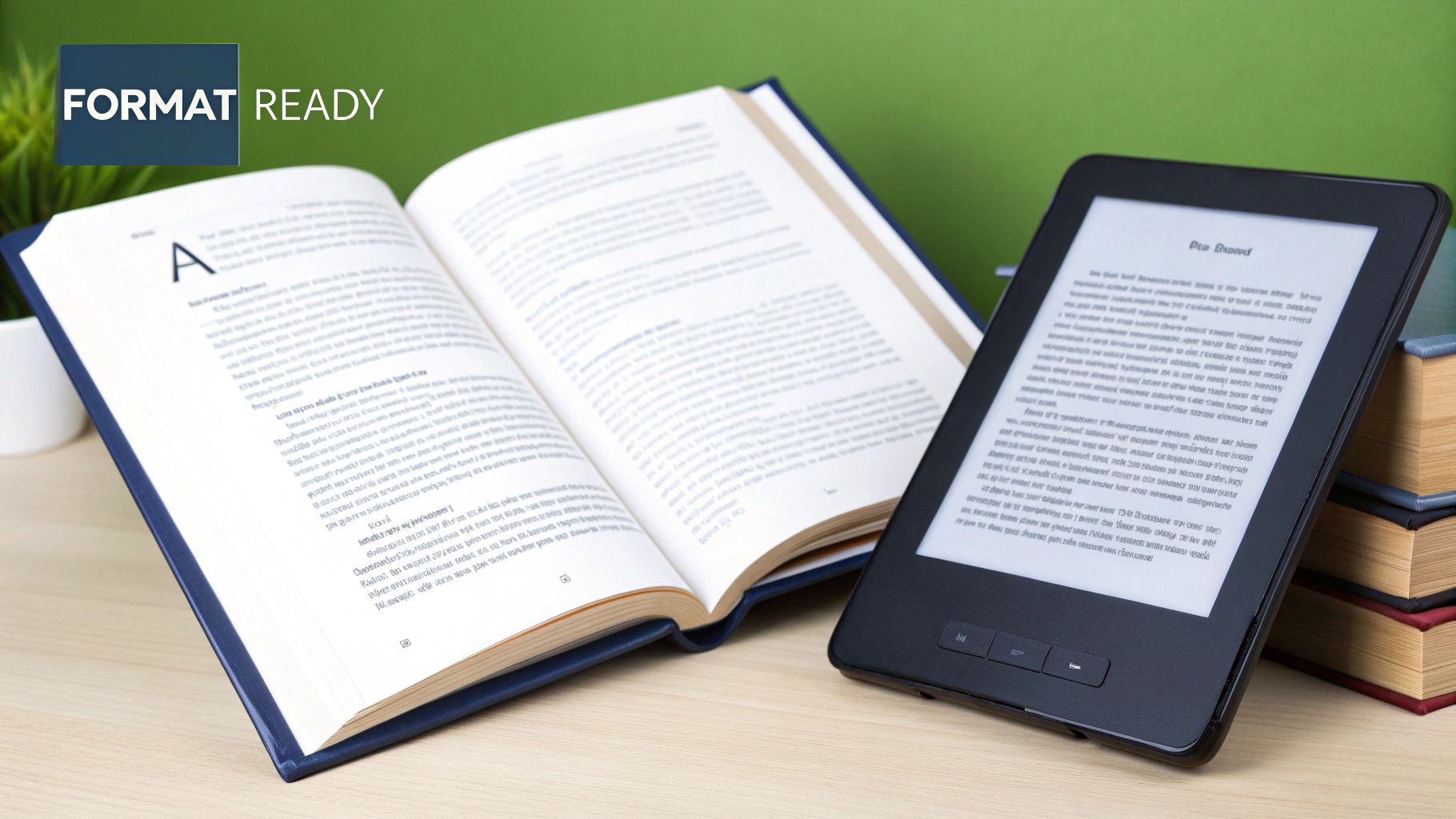
This isn't just bureaucratic red tape. It’s the backbone of the global book supply chain. Your paperback and your EPUB ebook are treated as completely different items in a retailer's inventory system. They have different production costs, prices, and distribution paths, so they can't share a product code.
When You'll Need a Fresh ISBN
The need for a new ISBN pops up more often than you might think. To keep your sales data clean and avoid major headaches with distributors, you must assign a new number for every single one of these versions:
- Paperback Edition: Your standard softcover print book.
- Hardcover Edition: A separate, premium product with its own manufacturing and pricing.
- Ebook Versions: This is crucial. Your EPUB file (for Apple Books, Kobo, etc.) and your Kindle version for Amazon need separate ISBNs.
- Audiobook Version: Whether it's a digital download or a physical CD.
This global standard is why you see such massive publishing numbers. In 2022, the UK alone published around 186,000 titles, a figure that reflects the countless formats authors release for each work. As the industry leans more into digital, accurate ISBNs are non-negotiable. You can learn more about this in the WIPO's 2022 global publishing report.
My rule of thumb is simple: if a customer can buy it as a separate item, it needs its own ISBN. This ensures every version of your book can be tracked, ordered, and discovered by retailers and libraries anywhere in the world.
What About Revisions and New Editions?
Okay, what about when you update your book? Do you need a new ISBN every time you fix a typo?
Thankfully, no. If you’re just making minor corrections—fixing spelling, grammar, or a few formatting glitches—you can keep your existing ISBN.
However, if you make significant changes to the content, you’ve created a new edition. At that point, a new ISBN is mandatory. This includes major updates like adding a new chapter, rewriting a large section, or removing a substantial amount of content. The new ISBN signals to the world that this is a different version of the work.
Common ISBN Questions for Authors
Getting your book out into the world is exciting, but the business side of things can feel a bit overwhelming. Let’s clear up some of the most common questions I hear from authors about ISBNs. Getting these right from the start will save you a world of headaches down the road.
Do I Need a Different ISBN for My Ebook and Paperback?
Yes, you absolutely do. This is one of the most critical rules to understand.
Every single format of your book is a separate product. Think about it from a retailer's perspective: a hardcover is a different physical item than a paperback, and an audiobook is a completely different digital file than an EPUB. They all need their own unique identifier for ordering, stocking, and sales tracking.
So, your paperback, hardcover, audiobook, and even different ebook formats (like a Kindle version vs. an EPUB for other stores) each require their own ISBN. Trying to use the same one across formats creates a logistical nightmare for distributors and can tank your sales before you even get started.
What Is the Catch with a Free ISBN?
The promise of a "free" ISBN from platforms like Amazon KDP is tempting, I get it. But there’s a major string attached: you give up control.
When you take a free ISBN from a platform, they list themselves as the publisher of record for that edition of your book, not you or your publishing company. This means that version of your book is permanently tied to their platform. You can't take a KDP-assigned ISBN and use it to sell your book on Barnes & Noble or Kobo.
If you ever want to "go wide" and reach a broader audience, you'll have to get a new ISBN that you own, with you listed as the publisher.
Can I Change Details on an Assigned ISBN?
Once you’ve assigned an ISBN to a specific title and format, it's set in stone. That number is now permanently linked to that book's core data. You can't just erase it and reuse it for another project.
Now, if you make a small typo in the metadata—say, you misspelled a word in the book's description—most official portals like Bowker will let you log in and fix it. But the fundamental assignment of that 13-digit number to that specific product is final. A major error might require contacting your national ISBN agency directly for help.
Should I Buy My ISBNs in Bulk?
If you have any plans to be a career author, the answer is a resounding yes. Buying a single ISBN is by far the most expensive way to do it. The cost per number plummets when you buy a block of 10 or 100.
For example, a single ISBN from Bowker can be pretty pricey. But when you buy a 10-pack, you can cut the cost per number by over 75%. For anyone serious about publishing more than one book—or even one book in multiple formats—a 10-pack is a no-brainer investment.
At BarkerBooks, we guide authors through every step of the publishing journey, including ISBN registration and copyright protection. If you're ready to turn your manuscript into a professionally published book, visit us at https://barkerbooks.com to learn how we can help.
